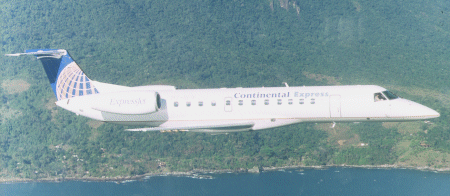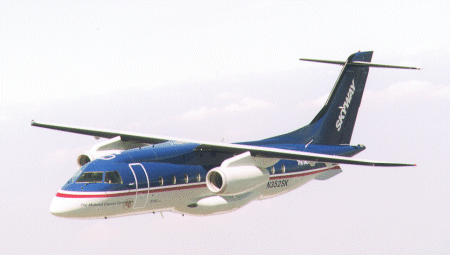Paul Lewis/Washington DC

The recent introduction of the new Embraer RJ-135 (above) and Fairchild Aerospace 328JET has heralded the entry into service of a completely new class of aircraft. The new 30/40-seat regional jets promise to revolutionise a part of the US market largely overlooked by the growing debate over scope clause restrictions and proposed 70-seat and larger jets.
It has been a surprisingly low-key debut for the ERJ-135 at Continental Express and American Eagle, and for the 328JET at Skyway Airlines. Their introduction, however, could have far-reaching implications for the 1,200 or so turboprops in US airline service, building on the foundations established by 50-seat jets.
According to US Regional Airline Association (RAA) president Walt Coleman, the new 30/40-seat jets represent another evolution of the regional fleet. "The pace of change will ultimately be driven by aircraft economics and market demand rather than by any artificial or regulatory considerations," he says.
If Continental Express is any measure of the forces at play, the switch from turboprops to jets is coming sooner rather than later. The airline has ordered 25 ERJ-135s, along with 75 larger 50-seat ERJ-145s. The carrier has indicated a need for twice that number of jets to meet its goal of phasing out its 46 to 64-seat ATR 42/72s, 19-seat Beech 1900Ds and 30-seat Embraer EMB-120 Brasilias within five years.
Continental Express president David Siegel says: "This aircraft is perfectly suited to replacing these turboprops at about the same cost, but producing much higher revenue. We can have jet range, speed and comfort, which drives higher revenue, and still have a cost-effective aircraft. We think the ERJ-135 is going to be the turboprop buster - eliminating turboprops from the US landscape."
Where 50-seat jets such as the ERJ-145 and Bombardier CRJ-100/200 have replaced 30-seat turboprops, load factors have risen, says the RAA, despite the extra capacity. The smaller jets are expected to have a similar impact on the 19-seat turboprop market, where the new aircraft are initially employed.
Continental's first two ERJ-135s have replaced Beech 1900Ds operating between Cleveland and Knoxsville, Tennessee; White Plains, New York; Chicago, Illinois; and St Louis, Missouri. The switch from turboprop to turbofan and from "non-cabin" to cabin class "produces two bumps, each worth about 30-50% in terms of increased traffic," says Siegel.
1900Ds replaced by jets

Similarly, Skyway Airlines is using the first of its five 328JETs to replace 1900Ds on routes from its Milwaukee base to Indianapolis, Nashville and destinations in Wisconsin. The Midwest Express Connection subsidiary will also use the 32-seat jet to open a route to Pittsburgh, which was not feasible with a turboprop.
For airlines that already operate 50-seat jets, the addition of a 35-seat derivative provides dispatch flexibility to optimise aircraft gauge to meet day-to-day seat demand. This was clearly a key factor in United Express carrier Atlantic Coast Airlines' (ACA) provisional order for 25 328JETs and 30 44-seat 428JETs. The jet will replace its British Aerospace Jetstream 32s (19 seats) and eventually J41s (29 seats).
"We believe that 32 and 44 seats are the right spacing for the market," says Stanley Deal, Fairchild vice-president for the 228/328/428 series. "We optimised it around what we think airlines are looking for and we think that, with some US scope clause definitions coming into reality, our choice will be proven right."
Most scope clauses only begin to cut in at 50 seats or higher, allowing for unlimited numbers of smaller jets. Even in the case where restrictions are tighter, such as that of United Airlines' 65-aircraft cap on its regional jet fleet, there are always opportunities elsewhere. This is underscored by ACA's new tie-up with Delta, which has generated a further order for 25 328JETs.
The only real constraint on supply is the rate at which manufacturers can build and deliver new aircraft. Order backlogs are growing and the fear that demand might outstrip supply is prompting other uncommitted regional carriers to speed up their evaluations and decision making. One such case is Embraer, which already has options in hand for 319 ERJ-135s and twice that number of the larger ERJ-145.
"In principle, we're sold out to the end of next year, aside from a small strategic reserve," says Satoshi Yokota, Embraer vice-president industrial. Because of this, the company will gear up production of ERJ-135/145s to 12 by the end of the year and increase its single line output to 16 within 18 months.
Fairchild has announced firm sales of 84 328JETs, along with other options. "This has all transpired in the last three to five months, principally in the US market," says Deal. "That focus has turned into an absolutely great market opportunity for us, with the 328JET coming on line and the 428JET launched. We feel really bullish about the revolution taking place."
Both manufacturers report large numbers of new 30-50-seat sales campaigns in North America. US Air Express recently released a request for proposals for 100 30/40-seat regional jets, along with up to 300 larger aircraft to re-equip Allegheny, Piedmont and PSA.
Turboprops' uncertain future
All this begs the question of what it means for the 1,200 turboprops operating in the USA. "As the aircraft come out of service, some are going to show up with other carriers, others will end up parked in the desert and some will leave the US market altogether," says Coleman.
The more immediate effect is being felt by the 19-seat turboprops such as the 1900, J31/32 and Fairchild Metro 23. The return of those aircraft on long-term leases, as with ACA's Jetstream fleet, invokes hefty financial penalties for the lessee. In many cases, however, the lessors appear willing to assist in disposals, if only to preserve the residual value of managed fleets from being undermined by a growing surplus of redundant 19-seaters. "Case-by-case, we're willing to work with them to reach a sensible financial compensation and market the aircraft elsewhere," says Steven O'Sullivan, executive vice-president of BAe's Asset Management Organisation (AMO).
Aircraft are instead exiting the USA for Latin America, with AMO placing five J32EPs with Aerocaribe of Mexico and another three with Aerolineas Argentinas Express start-up AeroVIP. Australia and New Zealand are also proving attractive, but limited, markets. "The quality of operators is good, but the deals are for ones and twos," says O'Sullivan.
The 30/40-seat turboprops will be next in line to feel the fall-out from regional jets. Some carriers have moved to dispose quickly of those still commanding a relatively high resale value of $3 million or more per aircraft. Continental Express has sold 10 of its EMB-120s, while American Eagle's recently acquired Business Express is phasing out 30 leased Saab 340s.
Many of these are finding a second lease of life as 19-seat turboprop replacements with smaller carriers unable to afford the $12 million cost of a new jet or not operating suitable routes. "My focus is on replacing 19-seaters with the 340 as new markets open up and carriers are able to step up to a 30-seater," says Michael Magnusson, president of Saab aircraft leasing.
The carriers actively looking on the market for 30-seat turboprops are typically small, all-propeller-equipped, affairs. Larger exceptions are Chautauqua Airlines, which appears set on maintaining a turboprop operation, and Horizon Air, which recently ordered 20 70-seatBombardier de Havilland Dash 8Q-400s. While the US turboprop fleet is set to contract, it will not disappear for the foreseeable future. There will be a continuing need for turboprops to operate short efficient routes of below 370km (200nm) and into small airports requiring short take-off and landing aircraft such as the Dash 8.
For mainline carriers, the entrée of the 30/ 40-seat jet offers the chance to focus on modernising the lower end of the regional aircraft fleet while tackling the vexing issue of scope clause at the high end. Continental's ERJ-135 faces "no artificial pilot constraints - its only limitation is economics and appeal, and in my mind there is no limit," says Siegel.
Source: Flight International
















